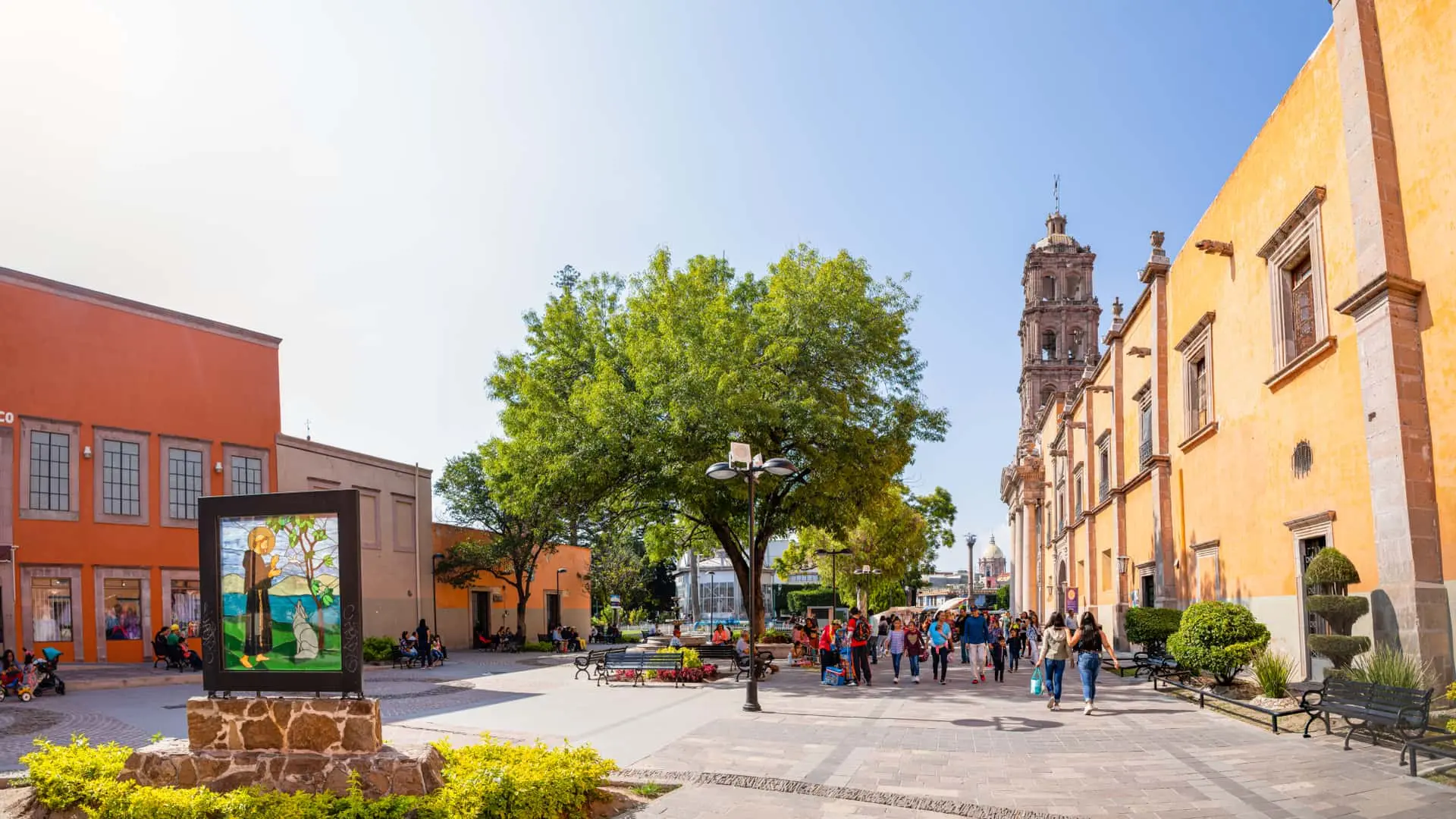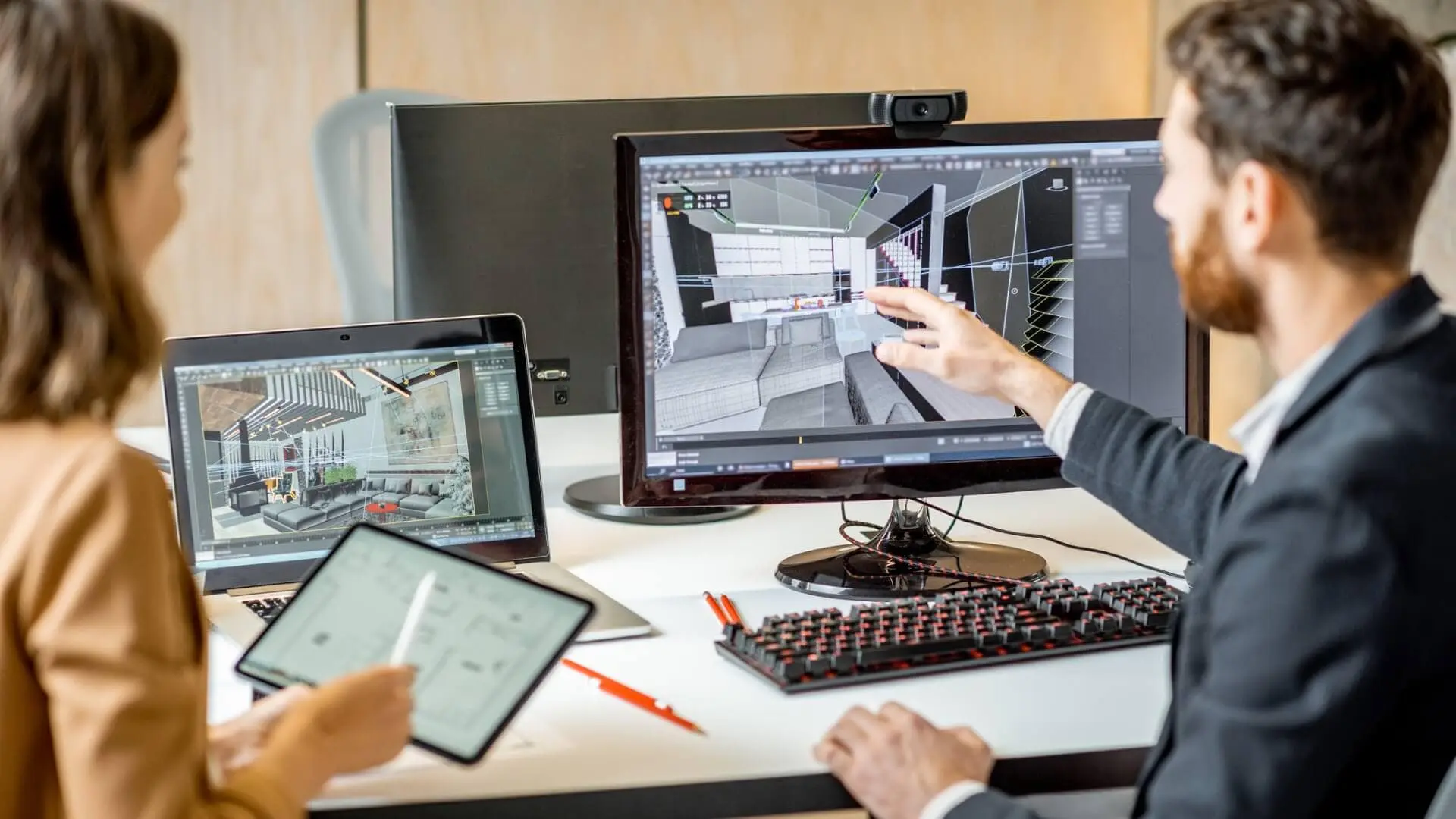BIM & DIGITAL TWINS IN LATAM
The development of smart cities in Latin America and the Caribbean is being boosted by advanced tools such as BIM and Digital Twins, which are essential for urban planning and management. BIM facilitates the creation of collaborative models of buildings and infrastructure, improving efficiency in construction and maintenance, while Digital Twins allow urban areas to be simulated and managed in real time, optimizing the use of resources. This transformation, supported by international standards, drives sustainability, efficiency and resilience in the region.
Tools for Designing Smart Cities
PRESENTATION
KAN Territory & IT, Trend Smart Cities, and the International Network of Smart Cities (RICI) worked together on developing this publication with the aim of providing a detailed overview of the state of the art in Building Information Modeling (BIM) and Digital Twins in Latin America and the Caribbean. The collaboration between these organizations seeks to aid in understanding the use of these technologies in Smart City applications, highlighting their impact on urban transformation and offering a mapping of various use cases in different cities.
KAN Territory & IT is a company specializing in developing custom technological solutions, focusing on digital transformation through strategic data use and process automation. They have a diverse team of professionals across different areas, including backend and frontend development, GIS analysis, among others.
Trend Smart Cities is a consulting firm that specializes in developing solutions for smart cities, focusing on the integration of technology and innovation to make cities more sustainable and humane. Founded by Lucía Bellocchio, it focuses on global projects with a strong presence in Latin America, working across different sectors to implement smart approaches in urban management.
RICI, a global organization dedicated to promoting urban transformation through advanced technologies, actively participates in promoting innovative and sustainable solutions in smart cities. Its mission is to foster collaborative work among governments, companies, and citizens to create intelligent and sustainable territories.
INTRODUCTION
BIM (Building Information Modeling) and Digital Twins are essential technologies for building and managing Smart Cities. BIM allows the creation of detailed digital models of buildings and structures, while Digital Twins digitally replicate entire cities or parts of them, enabling more effective and sustainable management. In Latin America and the Caribbean, implementing these technologies can significantly transform urban management and operational efficiency for local governments.
This document aims to provide an up-to-date view of the state of BIM and Digital Twin implementation. It discusses various organizational initiatives and strategies at both the regional and local levels in some countries. Additionally, it outlines various use cases, analyzing the challenges of implementation and the opportunities they enable.

WHAT IS BIM?
BIM (Building Information Modeling) is a collaborative methodology based on creating and managing digital information of a construction project throughout its lifecycle, from planning, design, construction, operation and maintenance, to material reuse.
BIM uses an intelligent 3D model that integrates geometric, spatial, and structural information and all elements that make up a construction, from design to maintenance and eventual demolition. A key aspect of the BIM methodology is the information added to objects, including material properties, specifications, classification, LOD (Level of Development), and LOI (Level of Information).
Some key components of BIM include:
-
3D Modeling: Three-dimensional representation of the project.
-
Database: Integration of all relevant data, such as materials, costs, schedules, and operations.
-
Collaboration: All project participants (architects, engineers, builders, etc.) work in a common, real-time updated model through the CDE (Common Data Environment).
BIM IN CITIES
In an urban context, BIM is used to design, build, and manage infrastructure and buildings within a city. This includes large projects like bridges and transport stations to managing residential and commercial buildings.
Here are some of the most significant applications of BIM in cities:
-
Urban Planning: BIM integrates with urban models to plan new developments or renovations, ensuring they fit the existing environment and comply with regulations.
-
Infrastructure Management: Enables efficient management of public infrastructures like water, electricity, and transportation networks, optimizing maintenance and operation.
-
Renovation and Maintenance: Facilitates the renewal of historic buildings and the lifecycle management of buildings, reducing costs and improving sustainability.
The main benefits of implementing BIM in a project are as follows:
-
Cost Reduction: BIM allows for identifying and resolving issues during the design and planning stages, reducing the need for costly changes during construction.
-
Improvement in Construction Quality: Data integration and 3D visualization ensure all aspects of the design are precise and coordinated, improving the final construction quality.
-
Efficiency in Infrastructure Management: BIM facilitates lifecycle management of urban assets, from design to demolition, optimizing maintenance and operation.
-
Collaboration and Transparency: The ability to share a common digital model in real-time improves collaboration among all project parties, increasing transparency and reducing errors.
WHAT IS A DIGITAL TWIN?
A Digital Twin is a virtual replica of a physical object, process, or system used to simulate, analyze, and optimize its real-time performance. This technology integrates data from sensors and other sources, allowing the digital model to accurately reflect the actual object’s state and behavior. Digital twins are fundamental in Industry 4.0, where they are used to predict failures, optimize performance, and plan asset maintenance; their use has recently expanded to urban settings.
Below are some sectors that implement digital twins:
-
Industry: In manufacturing, digital twins simulate and optimize production processes, foresee machine failures, and improve predictive maintenance.
-
Health: In the healthcare sector, they enable the creation of personalized models of organs or body systems for treatment and surgery planning.
-
Energy: In refineries and power plants, they optimize operations and maintenance, improving efficiency and reducing costs.
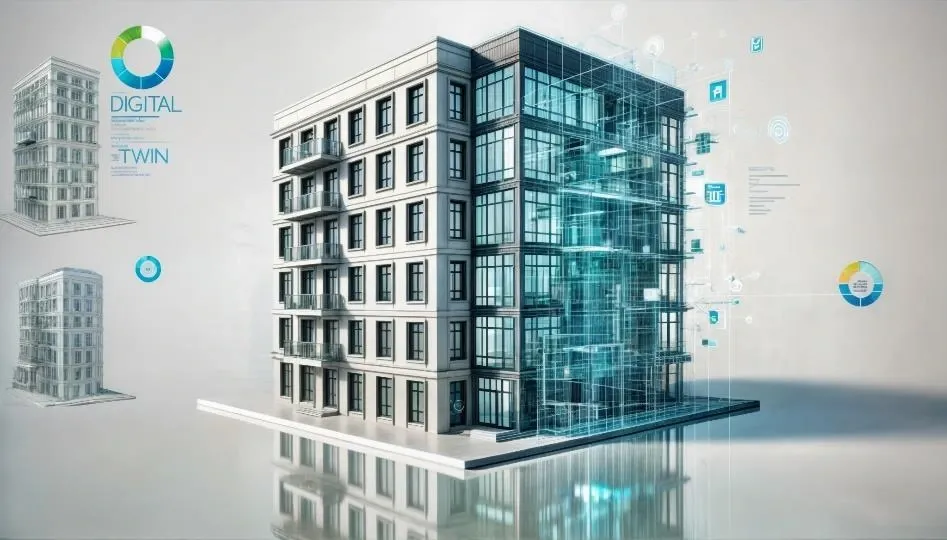
URBAN DIGITAL TWIN
An urban digital twin is a comprehensive digital representation of a city or urban area, integrating data from various sources like infrastructure management systems, public services, geospatial information, traffic, environmental conditions, human behavior patterns, among others. These urban digital models can be updated in real-time with information received from IoT sensors, reflecting changes occurring in the physical city.
The following are some key components of an urban digital twin:
-
Infrastructure: Digital representation of buildings, roads, bridges, and other physical infrastructures.
-
Public Services: Real-time information on water, electricity, gas supply, and other essential services.
-
Transportation: Traffic, public transport, and urban mobility data.
-
Environment: Monitoring air quality, temperature, noise, and other environmental factors.
-
Human Interaction: Information on how citizens use and move within the city.
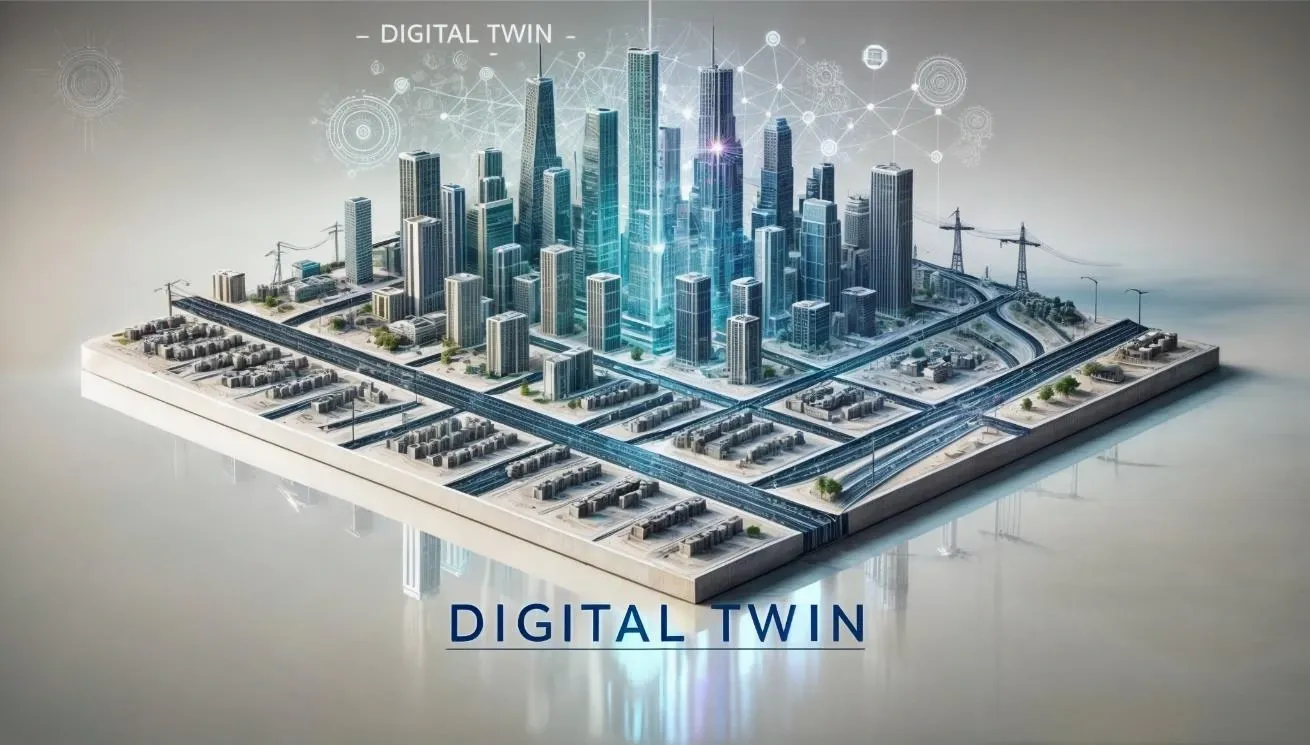
What is an Urban Digital Twin for?
An urban digital twin serves to simulate and analyze city behavior in various scenarios, facilitating decision-making in urban planning, infrastructure management, emergency response, and sustainability. City planners and administrators can foresee how infrastructure or policy changes will affect the city, optimizing resources and improving citizens’ quality of life.
The benefits achievable through digital twins’ implementation in a city or urban area are numerous. Some of the most important are as follows:
-
Decision-Making in Urban Planning: Urban digital twins allow city managers to make decisions based on real data and precise simulations, reducing error margins and improving public policy outcomes. Planners can also model the impact of new infrastructure or developments before construction.
-
Operational Efficiency Improvement: By continuously monitoring and analyzing the performance of urban systems, digital twins help optimize resource use, reduce costs, and improve public service efficiency.
-
Traffic Management: Optimizes transport routes and reduces congestion through real-time data analysis.
-
Sustainability and Resilience: Facilitates planning for more sustainable and resilient cities by predicting the impacts of various environmental and social scenarios and proposing solutions to minimize adverse effects.
-
Emergency Management: Simulates disaster or urban emergency scenarios to improve response and reduce risks.
-
Citizen Participation: Enables citizens to interact with the digital representation of their city, providing feedback and participating in the urban planning process.
BIM AND DIGITAL TWIN IMPLEMENTATION
Like the rest of the world, Latin America and the Caribbean are beginning to adopt BIM and digital twin technologies to transform their cities into Smart Cities, though the degree of implementation varies by country. Government efforts and private sector initiatives are driving this technological transformation, enhancing construction efficiency, infrastructure management, and sustainable urban development. Therefore, it is essential to continue strengthening technical and regulatory capacities to maximize the benefits of these technologies.
Regarding regulations and standards, several countries in the region are progressing in developing specific standards. However, adopting international standards like ISO 37120 (Indicators for sustainable cities), ISO 37122 (Indicators for smart cities), ISO 37123 (Urban resilience), ISO 37175 (Advanced technologies for smart cities), and ISO 19650 (Information management in BIM projects) is fundamental to ensuring data interoperability and quality in Smart City projects. These standards contribute to the efficient development, management, and operation of urban infrastructure through data digitalization, sustainability, and interoperability.
In this context, the aforementioned standards are interconnected in the field of smart cities. The infrastructure and buildings constructed and managed using ISO 19650 generate valuable data to monitor and measure their performance. This data is fundamental for urban performance indicators established in ISO 37120, which evaluates aspects such as energy efficiency, urban mobility, waste management, and air quality, all of which rely on BIM-standardized infrastructure. Similarly, BIM models form the basis for creating digital twins, addressed in ISO 37175. Digital twins extend BIM models by including real-time data on urban infrastructure performance, which can be integrated into smart city platforms to simulate and optimize city operations.
The Impact of the BIM Methodology and Digital Twins on Smart Cities
BIM is a collaborative work methodology that integrates all information related to a construction or infrastructure project throughout its lifecycle, from design to maintenance. This methodology facilitates coordination among the various actors involved, promoting collaboration and transparency in urban infrastructure planning and execution processes. Digital twins, which are virtual replicas of a city’s physical systems, enhance this capability by allowing real-time monitoring and simulation of urban infrastructure performance, providing managers and decision-makers with a comprehensive and dynamic view.
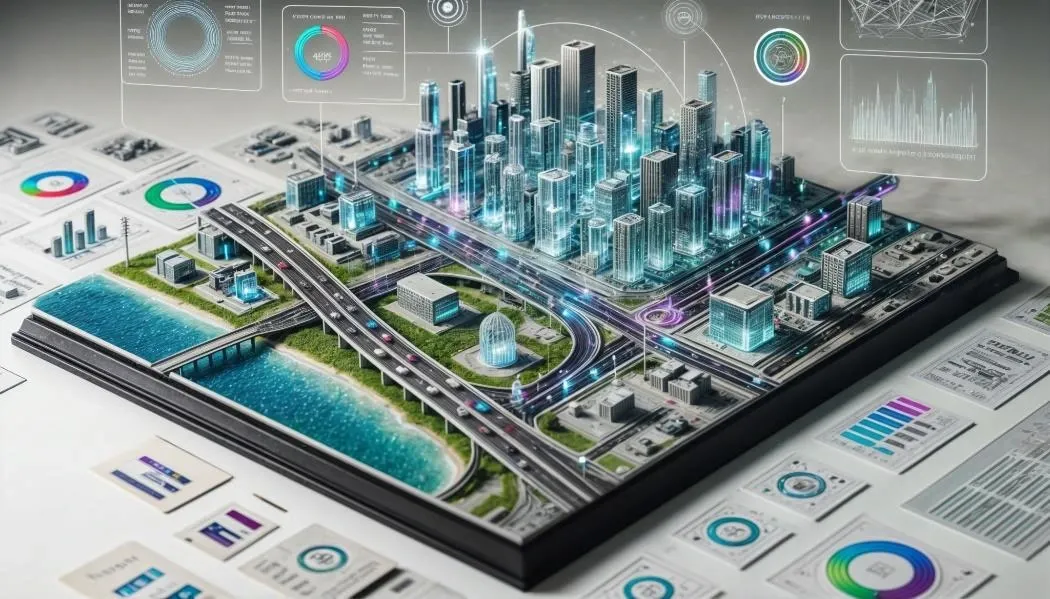
Interrelation between ISO Standards and the BIM Methodology in Smart Cities
Integrating advanced methodologies like BIM and technologies such as digital twins with international standards ensures that smart cities are developed under principles of sustainability, resilience, and efficiency. Here’s how each of the following ISO standards complements these approaches:
-
ISO 37120: Provides a set of global indicators to measure the performance of city services and quality of life. The data generated and managed through the BIM methodology is fundamental in supporting these indicators, such as water, energy, waste, and transportation management, offering a clear view for informed decision-making and improving urban well-being.
-
ISO 37122: Focused on smart cities, this standard offers indicators to evaluate the impact and efficiency of emerging technologies. As a collaborative, data-driven approach, BIM enables effective monitoring of smart urban systems, optimizing operations like energy management and critical infrastructure control, while digital twins enable real-time visualization and adjustment of these systems.
-
ISO 37123: Centered on urban resilience, this standard directly links to digital twins and the BIM methodology. Digital twins facilitate crisis scenario simulation and faster, more effective response planning, while BIM contributes to developing more robust, resilient infrastructure from the design stage, ensuring cities are prepared for disasters and critical situations.
-
ISO 37175: Addresses the use of advanced tools and technologies for smart cities, like IoT platforms and data infrastructure. By ensuring that cities adopt these technologies interoperably, ISO 37175 enables a smoother integration of data generated by BIM and digital twins, facilitating smart and efficient urban management. This standard supports the vision of cities as connected technological ecosystems that optimize urban resource use.
-
ISO 19650: Specifically designed for information management in projects applying the BIM methodology, this standard ensures data is managed throughout the project lifecycle, from design to maintenance. It also aligns with smart city standards, ensuring that collaborative data is efficiently shared among all involved parties, maximizing the value of urban projects.
Interoperability and Open Data Management
Interoperability between systems and platforms is one of the fundamental pillars for the success of projects using BIM and digital twins in smart cities. ISO 19650 provides a framework to ensure that information flows efficiently and is correctly shared among involved actors, while ISO 37175 ensures that technological platforms, such as IoT and digital twins, integrate and collaborate for effective urban infrastructure management. In this way, BIM acts as a catalyst to ensure that data is available and accessible throughout the project lifecycle.
Data Governance and Privacy
With massive digitalization and the use of advanced technologies in cities, like BIM and digital twins, there is a need to ensure the privacy and protection of citizens’ data. ISO 37123 and ISO 37122 include guidelines that guarantee that the data collected by these systems is used ethically, protecting users’ privacy and ensuring transparency in information handling. Using international standards also reinforces citizen trust in the technologies implemented in their cities.
Other Considerations
Other aspects, such as education and training, are essential for the successful adoption of these technologies. Universities and training centers in countries like Mexico and Colombia are incorporating BIM and Smart City management courses into their programs, although the offer remains limited. Likewise, access to advanced software tools is crucial. In Latin America, cloud solutions and open-source software are facilitating BIM and digital twin adoption, mitigating barriers related to license costs and technological updating.
REGIONAL SITUATION
At the regional level, several cooperation networks in Latin America and the Caribbean promote the use of BIM and digital twin technologies applied to Smart Cities, facilitating collaboration and project development in these areas. Here are some of the main networks and organizations:
Latin American Government BIM Network
The Latin American Government BIM Network (Red BIM Gob Latam) was created in 2019 to increase productivity in the construction industry through digital transformation, accelerating national BIM implementation programs through collaborative work that promotes common guidelines and favors trade and knowledge exchange in the region. It focuses on strategically planning BIM adoption from a government perspective, with strategic guidelines to promote BIM use in Public Works. The “Network” includes representatives from Argentina, Brazil, Chile, Colombia, Costa Rica, Mexico, Peru, and Uruguay.
Member countries of the Network promote an OpenBIM strategy, meaning they do not promote or require specific software brands but instead encourage and promote the free use of programs from different brands, ensuring that file exchange and digital data flow are conducted using interoperable formats like IFC, BCF, COBie, CityGML, gbXML, among others. OpenBIM promotes interoperability between different software and platforms, enabling a collaborative and efficient workflow in construction projects. This methodology aligns with open data and transparent governance principles that many local governments are adopting.
BuildingSMART
BuildingSMART International is a non-profit international organization dedicated to improving efficiency, sustainability, and collaboration in the construction industry by developing and promoting open standards for construction information, known as OpenBIM.
BuildingSMART has four main focuses: Standard Development, which involves creating open standards like IFC (Industry Foundation Classes) that enable data exchange across different software and tools used in building construction and operation. OpenBIM Promotion focuses on encouraging the use of open standards to collaboratively create and manage construction information models. Education and Training offers educational and training resources to support industry professionals in adopting and using open standards and BIM technologies. Finally, Certification provides certifications for software tools and individuals that meet its open standards.
In Spanish-speaking regions, BuildingSMART has a chapter in Spain, BuildingSMART Spain, which promotes the use of open BIM standards, facilitating interoperability and collaboration among different platforms and Spanish-speaking countries.
In Latin America and the Caribbean, Brazil is the only country with a local chapter, BuildingSMART Brazil. This chapter was formed in the framework of the BIM Forum Brazil in 2023 and is currently in its formative stage. Its vision is to promote the social, environmental, and economic benefits of open standards for infrastructure and construction information in Brazil.
Institute for Cities of the Future
The Institute for Cities of the Future (ICF) is an institution created by the City of La Plata Foundation, promoting methods for planning intelligent communities and tourist destinations in Argentina and Latin America. By using new technologies and participatory models, it assists communities in implementing innovative initiatives for sustainable, inclusive, and human development. The ICF works with internationally recognized methodologies developed by organizations like the United Nations (UN), the Inter-American Development Bank (IDB), FIWARE Foundation, the Argentine Institute of Standardization (IRAM), and the Spanish Association for Standardization (UNE), among others. The ICF aims to transform communities to improve visitors’ experience and residents’ quality of life.
SITUATION BY COUNTRY
Below is an overview of the adoption and application status of BIM and Digital Twin technologies in select Latin American and Caribbean countries. It also highlights public and private initiatives that, like at the regional level, aim to promote the use of these technologies, including practical cases showing their feasibility.
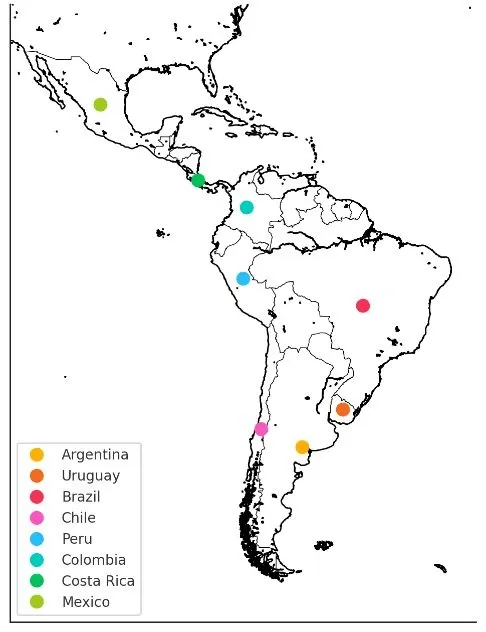
STRATEGIES AND INITIATIVES
Argentina - Strategies
In Argentina, several organizations promote and encourage the use and implementation of BIM across various sectors.
The government, through the Public Works Secretariat, developed the Argentina BIM Strategy under the SIBIM (BIM Implementation System) plan. Launched in 2016, the plan aims for most public works projects to adopt BIM in design and construction phases by 2025, including pilot projects, technical standards, training, and government policies.
The SIBIM plan aims to develop a coherent set of principles, guidelines, and procedures to regulate and establish a working methodology, study alternatives for national alignment regarding information management efficiency, quality in public works, inclusion, and technology neutrality, and to set references for expanding BIM use in Argentina.
The Argentine Chamber of Construction (CAMARCO), through the BIM en Acción platform, organizes meetings, documents, and articles for companies and firms looking to implement BIM. This promotes information exchange, collaborative work, and engagement among construction sector stakeholders.
BIM Forum Argentina was created in 2016 with CAMARCO’s support. This forum brings together companies, institutions, and professionals to promote BIM use in the construction industry. Its objectives include increasing knowledge about BIM’s benefits, best practices, workflows, and potential risks, reaching an international maturity level, fostering agreements around national standards, promoting BIM adoption in secondary and university curricula, advocating for normalization and proper BIM use in various applications, aligning private sector and government interests in BIM adoption, and participating in national and international events and congresses relevant to the Forum’s interests.
A report by the Forum in 2023 revealed that only 20% of respondents (professionals in civil construction) have BIM work experience, while 65% are in the initial training or adoption stage.
Uruguay - Strategies
BIM momentum in Uruguay began in 2016 with the creation of the Uruguay BIM Commission, later forming BIM Forum Uruguay, supported mainly by the Uruguayan Chamber of Construction (CCU).
BIM Forum Uruguay promotes and accelerates BIM adoption and implementation in Uruguay through research, dissemination, and training. The Forum comprises various entities, including CCU, the National Development Corporation (CND), academia, institutions, companies, professionals, students, and others interested in BIM nationwide.
The CND is a public legal entity that aims to be a national and international reference as a facilitator for implementing public development policies, providing services to ministries, municipalities, public and private companies. CND organizes National BIM Meetings to spread awareness and share knowledge.
The National BIM Committee oversees pilot projects developed by CND. Meanwhile, the Office of Planning and Budget (OPP) and seven state agencies created the BIM Strategy in Uruguay, establishing guiding principles for BIM in the country.
Brazil - Strategies
Brazil has developed a multi-agency strategy enabling progress on issues like regulatory development, standardized information generation, and pilot projects.
In the public sector, the Ministry of Development, Industry, Commerce, and Services (MDIC) leads the BIM Management Committee. This inter-ministerial body undertakes strategic actions, like defining BIM, formalizing a strategy, and planning a roadmap. The Ministry also launched the Construa Brasil project, which aims to improve the business environment in the construction sector by promoting modernization among companies. Goals include converging building codes, streamlining construction permit processes, disseminating BIM in Brazil, developing the BIM BR Strategy, and encouraging modular coordination and industrialized construction.
In the private sector, organizations like the Brazilian Chamber of Construction Industry (CBIC), in partnership with BIM Forum Brazil, developed technical information and BIM adoption guides to facilitate industry-wide process implementation. Meanwhile, the Brazilian Agency for Industrial Development (ABDI) has a project aimed at disseminating and adopting BIM in Brazil with two objectives: spreading information through the BIMBR Platform and training through the Democratizing BIM program.
Chile - Strategies
In 2015, the Chilean Chamber of Construction (CChC), through its Technological Development Corporation (CDT), created BIM Forum Chile to promote, facilitate, and disseminate BIM adoption to increase productivity and optimize construction industry projects. The Forum is currently promoting the creation of a Chilean chapter of buildingSMART.
In the public sector, CORFO (Production Development Corporation), the agency of the Ministry of Economy (MINECON) that supports entrepreneurship, innovation, and competitiveness, initiated actions to promote BIM from the State. Planbim, its BIM Initiative, aims to lead the standardized and cross-cutting BIM implementation in the industry.
Peru - Strategies
BIM implementation in Peru began around 2010, driven by large construction companies seeking to boost project productivity. This led to the creation of the BIM Committee within the Peruvian Chamber of Construction (CAPECO) in 2012.
Peru also has Plan BIM Peru, a policy measure promoted by the Ministry of Economy and Finance for adopting BIM in public infrastructure investments across the country.
In 2022, BIM Forum Peru was formed thanks to efforts from industry leaders and private companies. Its goal is to promote digital transformation in Peru’s design and construction industry through BIM adoption.
Colombia - Strategies
Colombia began isolated BIM initiatives in 2019, led by the private sector. These initiatives were consolidated to form the BIM Working Group, which unified efforts. With support from the Colombian Chamber of Construction (CAMACOL), BIM Forum Colombia (BFC was established as a platform for knowledge management around construction sector digitalization, aiming to boost company productivity and sector competitiveness.
Committed to digital transformation, CAMACOL and BFC created Ruta BIM, a business management tool for organizations to self-assess BIM adoption in their value chains and project teams.
The Transportation Infrastructure Planning Unit (UPIT) of the Colombian Government leads and coordinates with transportation sector entities to standardize BIM implementation processes across modes (road, rail, airport, river, port, and maritime). The National BIM Strategy was developed to foster collective construction within the sector, adopt, promote, develop, and disseminate BIM methodology.
Costa Rica - Strategies
Plan BIM Costa Rica started in 2018, but the national BIM proposal, led by the Ministry of National Planning and Economic Policy (Mideplan), wasn’t announced until 2019. The National Strategy was published in 2020, outlining the Government’s initial guidelines for BIM in public administration. In 2022, Mideplan published the Roadmap for BIM Adoption to leverage the State’s purchasing power for gradual BIM incorporation in public tenders, promote its use in the construction industry, and engage academic and private ecosystems to meet the required technical capacity and resources, setting short, medium, and long-term goals.
To support adoption, the Interinstitutional Commission for BIM Methodology Implementation (CII-BIM) was formed, with representatives from various institutions like Mideplan, the Ministry of Science, Technology, and Telecommunications, the Ministry of Public Education, the Ministry of Justice and Peace, the Ministry of Public Works and Transport, and the Costa Rican Institute of Aqueducts and Sewers, among others.
Alongside state efforts, BIM Forum Costa Rica was established by the Costa Rican Chamber of Construction (CCC) in 2018 to promote BIM. Another important player, the Federated College of Engineers and Architects of Costa Rica (CFIA), created the Permanent Joint BIM Commission in 2019. This commission, with representatives from five integrated professional colleges, addresses member needs and solutions to put BIM methodology into practice.
Mexico - Strategies
In 2013, BIM Task Group Mexico was created, inspired by a similar group originating in the UK. Since 2018, this group has led the formation of commissions to promote public policies, define regulations and standards, update academic curricula, drive business transformation, and disseminate the methodology’s benefits to the entire population. For example, the Industry Commission published the BIM Guide for SMEs in 2023, and the Government Commission published the BIM Adoption Guide for State and Municipal Governments.
In 2019, the Ministry of Finance and Public Credit (SHCP) launched the Construction Information Modeling (MIC) Strategy to improve public infrastructure development processes, enhance planning efficiency, reduce overruns in time and costs, and strengthen transparency and accountability.
In 2024, the Ministry of Infrastructure, Communications, and Transport (SICT) reaffirmed this commitment with a new announcement in the Official Gazette of the Federation (DOF). The announcement highlighted significant advancements in BIM standards and implementation, focusing on:
-
Scope Expansion: The 2024 agreement extended BIM adoption to include not only federally funded public infrastructure projects but also those executed through public-private partnerships (PPP) and infrastructure projects at the state and municipal levels. This expansion aims to accelerate digital transformation across all levels of government.
-
Advanced Interoperability Standards: New standards were announced to ensure interoperability between BIM platforms used in public projects, facilitating seamless data flow across different project life cycle stages and stakeholders.
-
Strengthened Training and Certification: In 2024, the government also established a national BIM certification program for both public officials and private-sector professionals. This program ensures that all involved parties are adequately trained in BIM, effectively applying the methodology in projects.
-
Sustainability and Energy Efficiency Goals: BIM usage is increasingly aligned with Mexico’s international commitments on sustainability and energy efficiency. New BIM-enabled projects must meet strict sustainability standards, ensuring construction and infrastructure operations minimize environmental impact.
With these advances, Mexico reaffirms its leadership in BIM adoption within the region, promoting profound digital transformation in infrastructure project management and enhancing the quality, transparency, and sustainability of public works.
Plan BIM Mexico is a non-profit organization that promotes digital transformation in the construction sector and the creation of sustainable, resilient infrastructure through the BIM-GIS methodology using open standards. In 2022, this organization published the BIM Guide for Public Tenders in Mexico, based on experience gained from pilot BIM projects in public tenders in the Government of Nuevo León, aimed at guiding the creation of future norms and laws.
The International Network of Smart Cities (RICI) is dedicated to creating more competitive, sustainable, and livable cities, fostering collaboration between the public, private, academic, and civil society sectors. RICI’s mission centers on promoting sustainable public policies and projects that generate positive social and economic impacts, encouraging the adoption of emerging technologies like the Internet of Things (IoT), Artificial Intelligence (AI), and Digital Twins. Combined with BIM, these technologies provide a comprehensive platform for smart urban development.
In this context, RICI in Mexico leads the Macro BIM Adoption Project nationally in collaboration with BIMe. The Macro BIM Adoption is a series of studies using scientific research methodology to systematically implement BIM in a country, covering critical areas like policies, standards, training, and technological adoption.
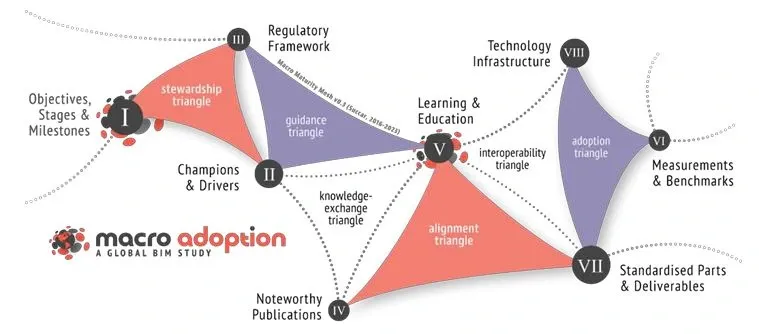
Source: https://bimexcellence.org/resources/200series/211in/
This project in Mexico involves organizations from different sectors nationwide, aiming to engage key actors in the macro BIM adoption study. This effort is part of a global collaboration involving countries like South Africa, Egypt, Spain, Brazil, Peru, Ecuador, and Colombia. The BIMe Initiative seeks to accelerate the digital transformation of the built environment through process innovation and open knowledge exchange, developing and providing open-access tools, templates, and resources such as BIMdictionary.com and Macroadoption.com.
Emerging Countries
Countries like Bolivia, Panama, and Paraguay currently have their own national BIM Forums. BIM Forum Paraguay has a strategic alliance with Miller&CO, a globally recognized Argentine BIM company. BIM Forum Bolivia is a non-profit organization initiated by BIM professionals to bring together leading professionals, companies, and institutions in Bolivia’s construction sector involved in BIM, focusing on technical development and dissemination. BIM Forum Panama is a permanent technical council gathering key professionals and institutions related to BIM in Panama and operates under the coordination of the BIM Technical Commission based at the Panamanian Chamber of Construction.
USE CASES
Argentina - Use Cases
A notable OpenBIM application case is BA Obras, a platform developed by the Government of Buenos Aires that enables communication and management of over a thousand public works projects. This platform uses OpenBIM standards to ensure that project data is accessible and reusable for any interested party. Information includes details on progress, costs, and contractors, allowing for effective citizen oversight and participation.
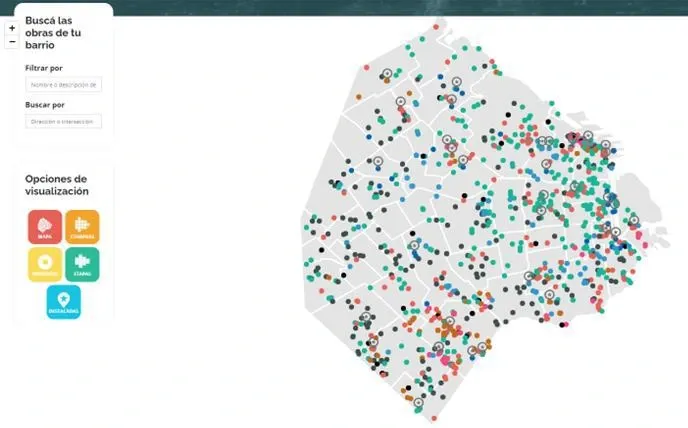
Source: https://buenosaires.gob.ar/ba-obras
Digital Twin adoption in Argentina is in its early stages, but a specific example of this technology is the Ciudad 3D platform by the Buenos Aires City Government, which virtually compiles the city’s urban plan in three dimensions. This digital tool allows 3D visualization of buildable areas, maximum heights, and urban surplus value by parcel, facilitating the interpretation of the Urban Code and expediting project approval processes.
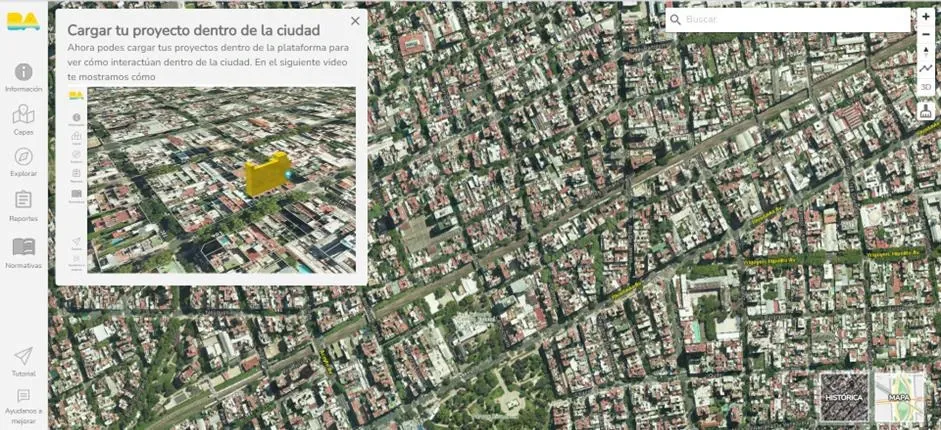
Source: https://ciudad3d.buenosaires.gob.ar/
Brazil - Use Cases
Curitiba is a world-renowned smart city, with over 100 kilometers of bike lanes; 7 out of 10 citizens travel by bicycle, and 70% of the population does not rely on private vehicles (with a system capable of serving the entire population), significantly reducing traffic and carbon dioxide generation. The city also has 52 m² of green space per person, over a million trees planted along streets and highways, and a network of 28 parks and forests.
In 2023, Curitiba received the Smart City of the Year award at the Smart City Expo World Congress. The recognition was due to the integration of public policies, innovative urban planning programs, and actions from an environmental sustainability and socioeconomic development perspective. Since the 1990s, Curitiba has been known for its efficient Bus Rapid Transit (BRT) system, integrating bus lines, modern terminals, and quick boarding stations.
Rio de Janeiro created an Operations Center, which, through a monitoring platform, integrates data from various sources to assist in crisis management, traffic, and weather conditions. Since its inauguration in 2010, the Rio de Janeiro Operations Center (COR) has monitored and coordinated public actions to reduce incident impacts using artificial intelligence. The Center employs over 500 professionals, averages 1,200 incidents per month, and features a monitoring structure linking more than 2,500 cameras across the city.
In collaboration with institutions like NASA and companies like Google, COR developed a decision matrix algorithm incorporating variables like mobility, rainfall, landslide and flood risk, heat zones, major event scheduling, and citizen-reported information. In real-time, COR broadcasts operational status levels from 1 to 5, ranging from normal to crisis stages, depending on the severity and interaction of circumstances.
Chile - Use Cases
Chile has seen significant developments in OpenBIM, such as the PARPro Platform, aimed at streamlining processes through automation in the review of public housing projects managed by Chile’s Ministry of Housing and Urban Development (MINVU).
In Punta Arenas, a Digital Twin called Punta Arenas 3D aids urban planning and resource management decision-making, focusing on resident welfare and development. This integrated territorial viewer contains valuable urban planning data such as road networks, public land, urban cadastre, constructions, infrastructure, basic services networks, feasibility studies, regional land-use plans, community organizations, local businesses, city vision, buildings, urban infrastructure, public services, and citizen and vehicle movement.
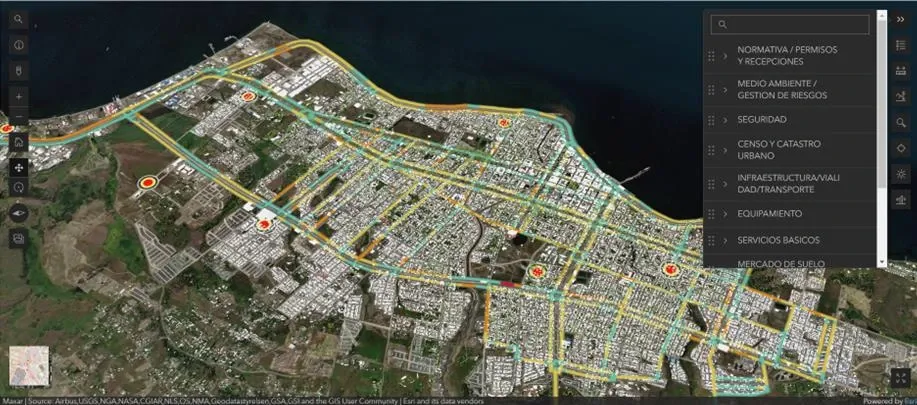
Source: https://www.gemelodigitalpuntaarenas.com/
Peru - Use Cases
A BIM model of Ayacucho, called Digital City with BIM, was created to serve as a virtual model for the city. This project, motivated by the need to preserve the cultural heritage of the historic center, addresses urban planning, social innovation, and lays the groundwork for a smart city management framework. The project utilized point cloud scanning technology (with drones and fixed scanners) and BIM modeling.
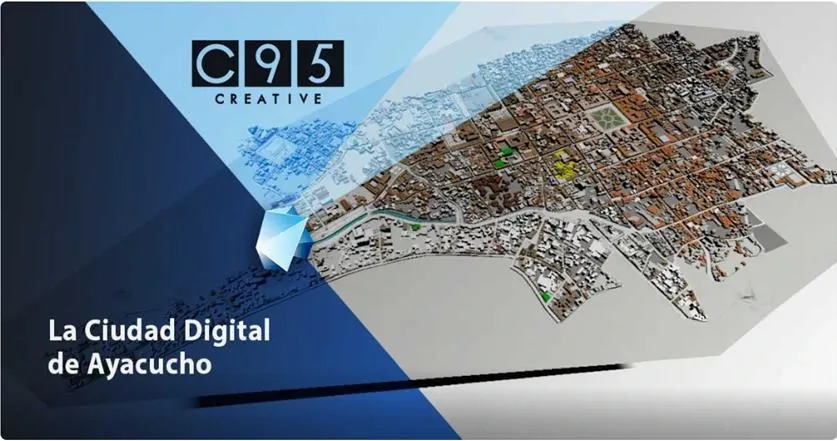
Source: https://editeca.com/la-ciudad-digital-de-ayacucho-bim/
Colombia - Use Cases
In San Cristóbal, Bogotá, an aerial cable transport system for over 400,000 passengers is under construction to promote efficient and sustainable mobility. This project, with three stations and 144 cabins over 2.8 km, is Bogotá’s first to incorporate the BIM methodology from the feasibility and design stages. A multidisciplinary team of about 200 professionals from around the world identified over 4,000 design conflicts, resulting in cost and time savings for the construction phase. Additionally, drone technology was used to digitize an area of over 1,500,000 m² to minimize the impact on the surrounding area.
In Bogotá, another project involves adapting various avenues for the Transmilenio System, which includes tasks like building public service networks, mixed lanes, BRT (Bus Rapid Transit) lanes, public spaces, cycling routes, connections to existing roads, signage, and traffic signals. BIM methodology was used in the project, identifying over 200 design conflicts, allowing preventive actions before execution.
In 2023, Barranquilla was recognized in the City Award category of the Smart City Expo World Congress (SCEWC) as one of the world’s leading smart cities. Key initiatives in Barranquilla include new technologies for restoring canals and marshes, generating and using solar energy for efficiency, urban planning focused on green spaces, connectivity, and sensor-equipped lighting for real-time monitoring.
Costa Rica - Use Cases
In Turrúcares, the Ventanas-Garita Hydroelectric Plant modernization project utilized BIM methodology for civil, electrical, and mechanical model development. The plant, an 8 km structure built between 1953 and 1958, was updated to extend its lifespan due to its age.
Mexico - Use Cases
The Gobernadores Viaduct in Campeche spans 1.8 km, impacting three major city avenues and adjacent areas, where over 10 km of surrounding streets were repaved as part of the urban improvement efforts. The project’s success was attributed to the involvement of large teams and companies using BIM for virtual construction, facilitating task review, and coordination among all specialties. Models were created from 2D plans of each specialty, and collaboration between the modeling team and field experts ensured material integration, specifications, brand standards, strengths, and comprehensive project analysis, documentation, and tracking.
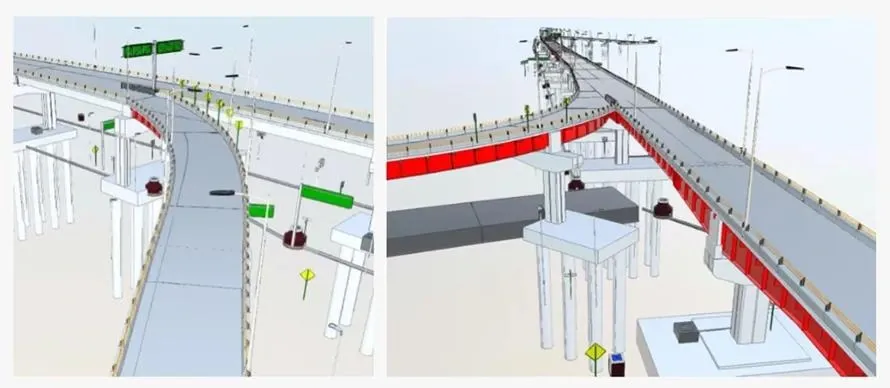
Source: https://www.bimtaskgroupmx.com/viaducto-gobernadores
The Felipe Ángeles International Airport is one of Mexico’s most significant assets, built with BIM to improve development processes, including planning efficiency, reduced delays and overruns, and strengthened transparency and accountability.
FINAL COMMENTS
As highlighted throughout the document, BIM methodology, combined with Digital Twins, IoT technologies, sensors, and digital systems, is fundamental to creating Smart Cities. These cities aim to be more sustainable, environmentally friendly, and beneficial for their residents, while optimizing resources and increasing resilience to climate change and technological advancements.
Across Latin America and the Caribbean, various initiatives and strategies are in place to promote the adoption of these technologies and coordinate their implementation. These efforts are evident in local government actions and private initiatives from companies and organizations.
The application examples and use cases presented here demonstrate the advantages and benefits of these methodologies in construction, urban planning, and resource optimization (both economic and natural).
For sustainable development, it is clear that Latin America and the Caribbean need to strengthen and increase the use of these new technologies, particularly in the construction industry and urban development and design.

SOURCES
-
Cabello, S. (2022). “El camino de desarrollo de las ciudades inteligentes: una evaluación de. Obtenido de Documentos de Proyectos (LC/TS.2022/86), Santiago, Comisión Económica para América Latina y el Caribe (CEPAL): https://repositorio.cepal.org/server/api/core/bitstreams/09242a54-2330-4059-b471-bf3909cc5e14/content
-
Red BIM de Gobiernos Latinoamericanos. (2023). Obtenido de Estrategias BIM de los países: https://redbimgoblatam.com/biblioteca/documentos/
-
Soto, C., & Manríquez, S. (s.f.). Panorama general del avance de BIM en América Latina y el Caribe. Obtenido de Editor: CAF. ISBN: 978-980-422-301-3.: https://scioteca.caf.com/handle/123456789/2022
-
Xia, H., Liu, Z., Efremochkina, M., Liu, X., & Lin, C. (Septiembre de 2022). Study on city digital twin technologies for sustainable smart city design: A review and bibliometric analysis of geographic information system and building information modeling integration. Obtenido de Sustainable Cities And Society, 84, 104009: https://doi.org/10.1016/j.scs.2022.104009
-
Zhu, J., & Wu, P. (12 de Mayo de 2021). Towards Effective BIM/GIS Data Integration for Smart City by. Obtenido de Remote Sens, 13(10), 1889: https://doi.org/10.3390/rs13101889
CONTACT US
-
KAN Territory & IT http://www.kan.com.ar info@kan.com.ar
-
Trend Smart Cities http://www.trend-smartcities.com contacto@trendsmartcities.com
-
RICI - Red Internacional de Ciudades Inteligentes http://www.redciudad.org info@redciudad.org
Download the newsletter now
Download